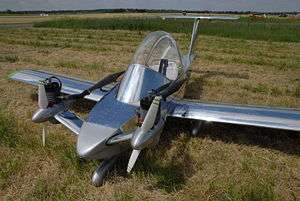Colomban Cri-cri
| Cri-Cri | |
|---|---|
 | |
| French-built homebuilt Cri-Cri at Airexpo 2007 | |
| Role | Homebuilt recreational aircraft |
| Designer | Michel Colomban |
| Introduction | 1973 |
| Status | In civilian use |
|
| |
The Colomban Cri-Cri (English: the chirp-chirp sound made by a cricket) is the smallest twin-engined manned aircraft in the world, designed in the early 1970s by French aeronautical engineer Michel Colomban.
Design and development
The Cri-Cri features a cantilever low-wing, a single-seat enclosed cockpit under a bubble canopy, fixed tricycle landing gear and twin engines mounted on pylons to the nose of the aircraft in tractor configuration. The aircraft is made from aluminum sheet glued to Klegecell foam. Its 4.9 m (16.1 ft) span wing employs a Wortmann 21.7% mod airfoil, and has an area of 3.1 m2 (33 sq ft). The aircraft is also capable of aerobatics within the limitations of twin-engined aircraft.[1][2]
Variants
- MC-10 Cri-Cri
- Model with a cruising speed of 170 km/h (92 knots, 105.6 miles per hour) and a range of 750 km (466 standard miles, 405 nautical miles).
- MC-12 Cri-Cri
- Model with a cruising speed of 185 km/h (100 knots, or 114.9 miles per hour) and range of 500 km (310.6 standard miles, 270 nautical miles).
- MC-15 Cri-Cri
- Model powered by two JPX PUL 212 15 horsepower (11 kW) engines.[1]
Operational use
As with any homebuilt aircraft, the existing Cri-Cri planes have often been modified by their builders, departing from the original design to a varying degree, resulting in varying performance. Most versions can climb with one engine inoperative.[3]
In June 2010, EADS partnered with Aero Composites Saintonge and the Greencri-cri Association to present an electric-powered Cri-Cri at the Green Aviation Show in Le Bourget. The modified airframe with composite components can fly for 30 minutes at 110 km/h. The aircraft uses four brushless electric motors with counter-rotating propellers, which makes the aircraft one of the world's smallest four-engine aircraft.[4]
On September 5, 2010 Electravia accomplished a world record speed of 262 km/h (162.33 mph) for a lithium polymer-powered aircraft using a Cri-Cri with two electric motors (each producing 25 hp) during the attempt. The company claimed engine and cooling drag reductions of 46 percent versus the conventional combustion engine arrangement.[5]
On 9 July 2015 the electric-powered version of the design flew across the English Channel hours before the Airbus E-Fan,[6] becoming the third electric aircraft to do so. It was pulled aloft by another aircraft and did not take off on its own.[7][8] The first was the MacCready Solar Challenger in 1981[9] and the second used electric motors powered by hydrogen.[10]
Specifications (MC 15)
Data from Michel Colomban[11]
General characteristics
- Crew: one
- Length: 3.9 m (12 ft 10 in)
- Wingspan: 4.9 m (16 ft 1 in)
- Wing area: 3.1 m2 (33 sq ft)
- Airfoil: Wortmann 21.7
- Empty weight: 78 kg (172 lb)
- Max takeoff weight: 170 kg (375 lb)
- Powerplant: 2 × JPX PUL 212 single-cylinder piston engines, 11 kW (15 hp) each
- Propellers: 2-bladed
Performance
- Maximum speed: 220 km/h (137 mph; 119 kn)
- Cruise speed: 185 km/h; 115 mph (100 kn)
- Range: 463 km; 288 mi (250 nmi)
- Service ceiling: 3,700 m (12,139 ft)
- Rate of climb: 6.6 m/s (1,300 ft/min)
- Wing loading: 55 kg/m2 (11 lb/sq ft)
Related content
- Aircraft of comparable role, configuration and era
References
- 1 2 Bayerl, Robby; Martin Berkemeier; et al: World Directory of Leisure Aviation 2011-12, page 110. WDLA UK, Lancaster UK, 2011. ISSN 1368-485X
- ↑ Lednicer, David (2010). "The Incomplete Guide to Airfoil Usage". Retrieved 7 October 2012.
- ↑ "Big fun in small package". 2014. Retrieved 1 December 2014.
- ↑ EADS (18 June 2010). "Cri-Cri, the all-electric aircraft". Archived from the original on 29 June 2010. Retrieved 7 October 2012.
- ↑ "Cri Cri sets electric speed record". Sport Aviation. January 2011.
- ↑ http://www.telegraph.co.uk/finance/newsbysector/industry/engineering/11729838/Airbus-E-Fan-2.0-set-to-recreate-aviation-history-with-cross-Channel-flight-only-this-time-its-electric.html
- ↑ "Did Duwal Beat Airbus Across the Channel?". AVweb. Retrieved 10 July 2015.
- ↑ Bertorelli, Paul. "Airbus' Asterisked Record". AVweb. Retrieved 10 July 2015.
- ↑ "First Electric-Powered Channel Flight Was 34 Years Ago". AVweb. Retrieved 13 July 2015.
- ↑ "Man of La Manche". CAFE Foundation. Retrieved 10 July 2015.
- ↑ Cri-Cri MC 15 Information Pack - Michel Colomban
External links
| Wikimedia Commons has media related to Colomban Cri-cri. |